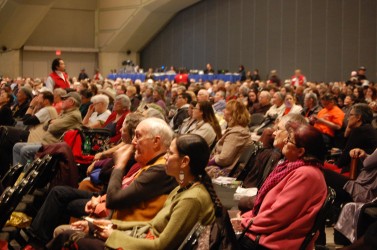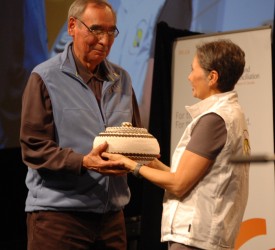Article Origin
Volume
Issue
Year
After a week of milder weather in Edmonton, the opening day of the Truth and Reconciliation Commission’s final national event was met with snowfall.
“An Elder told me the snow came because it’s a form of cleansing,” said Assembly of First Nations Alberta Regional Chief Cameron Alexis, who addressed a packed hall at the Shaw Conference Centre.
Cleansing, healing, sharing, learning were all evident in the four-day event that ran from March 27-30 with 3,243 survivors registered, 420 statements gathered, and attendance averaging 8,500 each day. Federal, provincial and municipal governments committed to various acts that would lead to both the sharing of Canada’s darkest period of history as well as working toward reconciliation. Youth stood strong willing to take on the mantle of leadership. Churches beyond the four that signed the Indian Residential School Settlement Agreement apologized and pledged to walking the path with survivors and their families. Honourary witnesses promised to follow through with their task of teaching about the legacy of residential schools. People from around the world tuned into the TRC’s webcast with over 30,000 streams to 36 countries.
“I am inspired by the stories that we have heard and the dialogue and commitment to reconciliation that we have witnessed… I have been moved by the incredible generosity of spirit that we have seen from survivors and from the intergenerational survivors… I was brought to tears by the acts of love you showed each other,” said TRC Chair Justice Murray Sinclair in the closing ceremony.
Edmonton marked the last of seven national events to be hosted by the TRC, through the mandate it received from the IRSSA. The first event was held in Winnipeg in 2010. The closing ceremony is a single day event to take place in Ottawa in 2015. The TRC received a one-year extension on its original five-year mandate. Sinclair said the TRC may hold a series of one day events in the coming year throughout the country in order to hear from more survivors and their descendants.
Sinclair noted that in moving forward on the issue of reconciliation, the commission will be meeting with specific groups, including Elders, youth, women, the lesbian-gay-bisexual-transgender community, to hear what they think the TRC should say about reconciliation in the final report.
Sinclair warned that achieving reconciliation will not be easy.
“Reconciliation is going to be damned hard work. If you thought the truth was hard, reconciliation is going to be even harder,” he said. “By discovering what we have discovered and what we have talked about and what we have (told) the Canadian public, we have revealed things that people did not expect to know, that people did not expect to see and hear about. And it has caused anger on the part of survivors and their families. It has caused anger in the Aboriginal community generally. It has caused anger from the part of those who get the blame about all of this.”
Responding to that reaction, said Sinclair, will be a vital part of the commission’s work.
“We have to put forward a plan that takes into account that anger, which we have… helped to create by opening this doorway. But anything that results from a dialogue that does not include that knowledge would be useless,” he said. “That is why we must now embark on that conversation of reconciliation.”
In writing the final report, a task the commission has already begun, Sinclair said academics and political leaders will have role to play.
“We want the voice of our report to be strong, we want it to be inclusive and we want it to be in a direction that people understand,” said Sinclair.
He also stressed that youth will be driving this move to reconciliation and while “we need to… ensure that they are aware of the past (we must ensure) they do not carry all the burdens of the past including the frustration, the anger and the pain.”
In a poignant moment prior to the closing ceremony, David Langtry, acting chief commissioner of the Canadian Human Rights Commission, and one of the newly inducted honourary witnesses, offered for the Bentwood box two blankets that wrapped his twin grandchildren.
The blankets, he said, were “an acknowledgement that non-Aboriginal Canadians failed in our collective responsibility to protect and nurture thousands of Aboriginal children from coast to coast to coast. Not only did we fail in that responsibility but we caused grave and sometimes irreparable harm. We acknowledge this past, accept responsibility and ask your forgiveness. But finally, though, I give these blankets to reflect my hope that the generation of my grandchildren will be the generation that realizes true reconciliation and equality with Aboriginal peoples.”
- 2979 views


